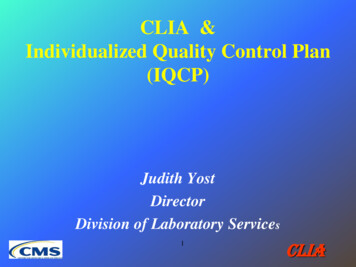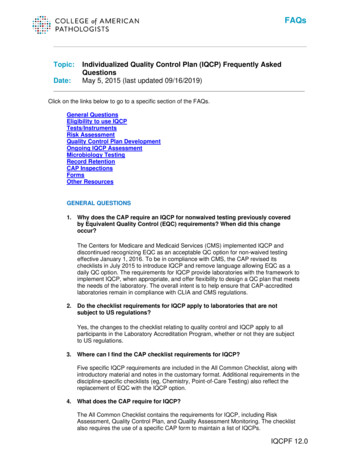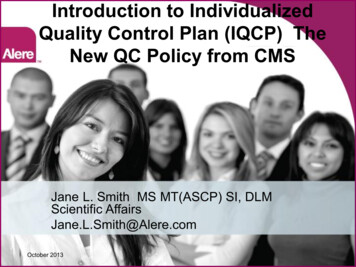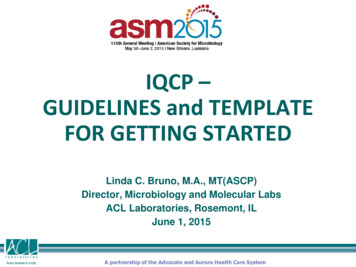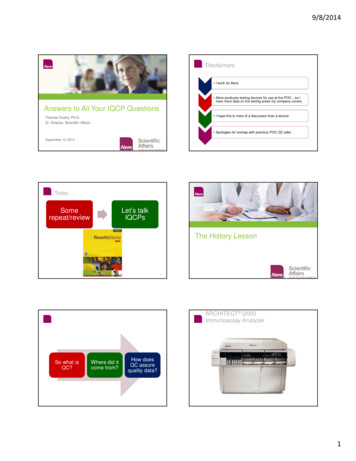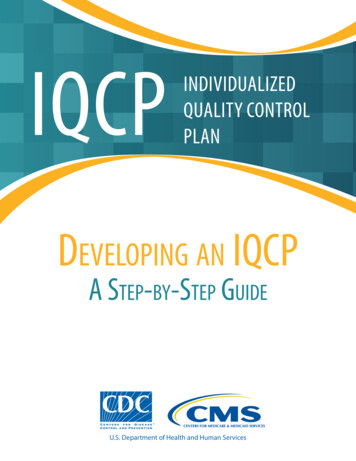
Transcription
IQCPINDIVIDUALIZEDQUALITY CONTROLPLANDeveloping an IQCPA Step-by-Step GuideU.S. Department of Health and Human Services
INSTRUCTIONS – IQCP WORKBOOK FILLABLE FORMSThis step-by-step instructional guide walks readers through the processof developing an IQCP that can be sustained and modified, as needed. Itdemonstrates how laboratories can perform a risk assessment to evaluateand record their current quality activities using the IQCP Risk Assessmentworksheet, create a Quality Control Plan from the risk assessmentinformation, and establish a Quality Assessment for the test system beingevaluated for an IQCP.IQCPINDIVIDUALIZEDQUALITY CONTROLPLANDeveloping an iQCpa Step-by-Step guiDeINSTRUCTIONS FOR FILLING OUT THE DOCUMENTYou may, but you are not required to, use these worksheets to complete thesteps of performing an IQCP. As you work through this workbook, you mayenter the information for each IQCP directly onto the worksheets that followfor the Risk Assessment, Quality Control Plan and Quality Assessment; thecells will not expand to accommodate your information. The number of boxes for each form is fixed andwill not change, and the amount you can type into each box is limited. Once complete, you may save thedocument or print a hard copy, as needed.U.S. Department of Health and Human ServicesTo save the documentFollow the instructions provided for your computer’s operating system to SAVE the file in the location ofyour choice.To print the documentFollow the instructions provided for your computer’s operating system to PRINT the complete file or selectthe specific page number(s) to print.IQCP Workbook:For additional IQCP resources and the “Developing an IQCP; A Step-By-Step Guide”, you may access anddownload free of charge by visiting the CDC’s website at:http://wwwn.cdc.gov/clia/Resources/IQCP/Or visit the CMS website gislation/CLIA/Individualized Quality Control PlanIQCP.html
INTRODUCTIONOVERVIEWThe Clinical Laboratory Improvement Amendmentsof 1988 (CLIA) regulations require a laboratory tohave quality control (QC) procedures to monitorthe accuracy and precision of the complete testingprocess. A QC option is now available that providesyou the opportunity to tailor an individualizedquality control plan (IQCP) for your unique testingenvironment and your patients. The IQCP option offersyour laboratory flexibility for meeting regulatory QCrequirements appropriate for the testing you performand when you add a new test.IQCP is an all-inclusive approach to assuring quality. Itincludes many practices that your laboratory alreadyuses to ensure quality testing beyond requiringthat a certain number of QC materials be tested ata designated frequency. IQCP can be applied to allnonwaived testing performed, including existingand new test systems. All CLIA specialties andsubspecialites except Pathology are eligible for IQCP.Adoption of an IQCP will not necessarily reduce your QC testing practices. It will allow you to developcustomized QC for your laboratory specific to specimens you test, your test system, reagents, environment,and testing personnel.Prior to going through this workbook, you may find it beneficial to review CLIA brochures #11, 12, and 13developed by The Centers for Medicare & Medicaid Services (CMS) for a general overview of egislation/CLIA/CLIA Brochures.htmlPURPOSEThis workbook is designed to assist in developing an IQCP for one or more test systems. Using an examplescenario, the workbook will guide you through a step-by-step process to develop an IQCP that can besustained and modified, as needed, over time. You will evaluate your current quality activities and developan IQCP worksheet which, when completed, can serve as your IQCP document. The approach outlined in thisworkbook is not mandatory or the only format for documentation, but is one example that can be used. Youare free to develop your own format that meets the needs of your laboratory.At the completion of this workbook you will have performed a Risk Assessment,created a Quality Control Plan, and conducted a Quality Assessment for the test systembeing evaluated for an IQCP.1
TABLE OF CONTENTSIntroduction. 1Overview. 1Purpose. 1Why do an IQCP?. 4What are the three steps of the IQCP?. 5What are we already doing?. 6Step 1: Risk Assessment7How do I get started?. 8What is happening in my laboratory?. 9Assessing Specimen Risks.11Assessing Test System Risks.15Assessing Reagent Risks.19Assessing Environment Risks.23Assessing Testing Personnel Risks.27Step 2: Quality Control Plan35What is a Quality Control Plan (QCP)?.35What is included in a QCP?.35Developing your QCP.36Happy Day Physicians Group QCP Example.37Optional QCP Worksheet.40Tips to remember.41Step 3: Quality Assessment42What is Quality Assessment (QA)?.42Documents to Consider for QA.44Does your QA do the following?.45Happy Day Physicians Group QA Example.45Optional QA Worksheet.48continued on next page.2
TABLE OF CONTENTS (CONTINUED.)Let’s review.49APPENDIX52APPENDIX A - Risk Assessment Worksheet.52APPENDIX B - QCP Worksheet.57APPENDIX C - QA Worksheet.58APPENDIX D - Additional Risk Assessment Questions.59APPENDIX E - QA Activities.61APPENDIX F - Glossary / Definitions.62DISCLAIMER:This workbook is not a legal document. The official CLIA program provisions arecontained in the relevant law, regulations, and rulings. For more information, you mayaccess the regulations on the internet at http://www.cdc.gov/clia/.3
WHY DO AN IQCP?An IQCP offers flexibility in achieving QC compliance and allows you to:99Customize a QC Plan for each nonwaived test in its unique environment99Optimize the use of electronic/integrated controls99Adapt testing practices for advances in technology99Incorporate other sources of quality information into the QC Plan99Strengthen partnerships with manufacturers99Formalize the risk management data already maintained within the laboratory99Provide equivalent quality testing to meet the CLIA QC regulationsThe IQCP approach is voluntary. If you do not choose to adopt an IQCP, your laboratory must test twolevels of external controls on each test system for each day of testing and follow all specialty/subspecialtyrequirements in the CLIA regulations for nonwaived tests.4
WHAT ARE THE 3 STEPS OF THE IQCP?The IQCP process includes: Risk Assessment, QualityControl Plan (QCP), and Quality Assessment (QA). AnIQCP must address the potential failures and errorsidentified in the entire testing process: preanalytic,analytic and postanalytic phases of testing.1. RISK ASSESSMENTA Risk Assessment identifies and evaluatespotential failures and sources of errors in yourtesting process. It must include, at a minimum, anevaluation of the following five components: Specimen Test system Reagent Environment Testing personnel2. QUALITY CONTROL PLAN (QCP)A Quality Control Plan is a written document describing the practices and procedures performed byyour laboratory to reduce the chance of possible failures and errors in your test processes. The QCP mustensure that the accuracy and reliability of test results, for a specific process, are appropriate for patientcare. Practices, procedures, and resources that you incorporate in your QCP may include, but are notlimited to: Electronic controls Internal controls Proficiency testing (PT) Calibration Maintenance Training and competency assessment3. QUALITY ASSESSMENT (QA)Quality Assessment is the continuous process of monitoring the effectiveness of the QCP. Practices,processes, and resources to consider for monitoring effectiveness of a QCP may include, but are notlimited to: QC reviews PT performance reviews Chart reviews Specimen rejection logs Turnaround time reports Complaint reports5
WHAT ARE WE ALREADY DOING?Gather and review information already available to yourlaboratory about the testing process, such as manufacturer’sinformation, data you obtained through verification orestablishment of performance specifications, historical QC andPT data, as applicable.The steps listed below will help you determine if your currentquality procedures are adequate or if additional or differentactivities are needed to reduce potential failures and errors.1. Review the preanalytic, analytic, and postanalytic phases of the testing process.2. Break down each phase into steps, so that potential failures and errors can be identified.3. Analyze the information gathered to see if control activities can be put into place to reduce theidentified potential failures and errors.6
Step 1: Risk AssessmentA risk assessment is the process of identifying andevaluating the potential failures and errors that couldoccur during the preanalytical (before testing), analytical(testing), and postanalytical (after testing) phases oftesting.At a minimum, evaluate the following five components ofthe testing process for potential failures and errors: specimen test system reagent environment testing personnelSome risks could fit under more than one of the fiverisk assessment components. When conducting the riskassessment, identify the risks under the component that ismost appropriate for your laboratory.For example, an inadequate specimen volume (i.e. 0.5 ml of whole blood might be collected insteadof 1.0 ml as specified by the manufacturer’s instructions) could fall under more than one risk assessmentcomponent:1. Specimen- manufacturer’s instructions specify a minimum of 1.0 ml whole blood for the testsystem, or2. Test System- wrong specimen volume would result in the reporting of wrong result or test systemprocedural error, or3. Reagent- incorrect specimen volume would result in the test kit reagents performing improperlyand producing incorrect test results.PreAnalyticalSpecimen*Test t*Testing Personnel7
STEP 1: RISK ASSESSMENTHOW DO I GET STARTED?To begin your risk assessment, review and assess all manufacturers’ information and other applicableresources including, but not limited to:99Laboratory procedures/standard operating procedures (SOPs)99Manufacturer’s instructions/package inserts99Instrument and troubleshooting manuals99Manufacturer’s alerts and bulletins99Calibration data99Data obtained through verification or establishment ofperformance specifications99FDA alerts99Historical QC data, including data from a previously conductedequivalent quality control study99Instrument correlation data99PT results and data99Records of complaints and corrected reports99Regulatory and accreditation requirements99Scientific publications99Test process flow charts or maps99Testing personnel training and competency records Pay special attention to the following package insert sections: intended use, patient preparation,limitations, environmental requirements, QC frequency, specimen requirements, reagent storage,maintenance, calibration, interfering substances. If you have questions concerning the manufacturer’s instructions or need additional information, contactthe manufacturer directly. In laboratories with multiple, identical test systems (same make and manufacturer), a single riskassessment may be performed. However, differences in testing personnel and environments where thetest systems are used must be taken into consideration. Due to these differences, you should determineif you need to perform a risk assessment for each individual location and/or device.8
STEP 1: RISK ASSESSMENTWHAT IS HAPPENING IN MY LABORATORY?The following is an example scenario for you to refer to throughout this workbook. The example is based ona fictitious laboratory and test system. It contains information about the laboratory, test system, and otherpertinent information the laboratory has or can acquire in order to develop and implement an IQCP.ScenarioDr. Martin is the laboratory director for the Happy Day Physicians Group. She is consideringimplementing an IQCP for her laboratory. To determine if IQCP is a good option for Happy DayPhysicians Group’s laboratory to meet CLIA QC requirements, Dr. Martin has asked her laboratorysupervisor, Kim, to take the lead in performing a risk assessment.Kim decided to evaluate the test for magnesium performed on the Acme Chemotrific SystemMagnesium because the manufacturer’s instructions recommended performing external QC lessfrequently than required by CLIA. She gathered supporting data to review what her laboratory iscurrently doing to reduce potential sources of error.Supporting Data99 Test system is FDA cleared and moderate complexity under CLIA99 Laboratory follows the CLIA regulatory requirements for QC - two control materials of differentconcentration each day of patient testing99 Acme Chemotrific System-Magnesium package insert includes: Specimen collection time and collection tube requirements Limitations of the test Criteria for acceptable results Use of an internal control process that performs internal QC on every reagent disc Recommendations for performing external controls at least every 30 days; when there is asignificant change in laboratory conditions; training or retraining of personnel is indicated; orwhen test results do not match patient symptoms or clinical findings99 Two years of successful PT performance reports99 Test performance specification verification studies demonstrating the test system’s accuracy andstability99 Specimen - Review of specimen receipt logs for the past two years demonstrates gaps indocumentation when requesting re-collection of specimens.9
STEP 1: RISK ASSESSMENT99 Instrument maintenance (Test System) Review of instrument maintenance logs show no problems with test system’s instrumentmechanics for the past two years Review of patient test results and two levels of external QC results for the past two yearsdemonstrates no problems with the test system. QC outliers were resolved with corrrectiveactions. Review of troubleshooting logs demonstrate no indication of problems with the test system orpatient results reporting for the past two years99 Reagent- Review of lot-to-lot reagent logs demonstrates no problems or indications of problemsfor past six months99 Environment: Room temperature logs- Review of temperature logs demonstrates no problems withtemperature for past year Refrigerator and freezer temperature log- Review demonstrates minimal outlier temperaturepoints with investigation and appropriate corrective action for the past year99 Testing personnel training and competency – Review of personnel training records for the pasttwo years demonstrates no personnel turnover.*NOTE REGARDING SUPPORTING DATA: Support your risk assessment with available data that include, butare not limited to, test performance specifications, manufacturer’s package inserts, PT performance data, QClogs/data, specimen receipt and rejection logs, to determine a QC plan that will reduce potential sources oferror.Now let’s review your supporting dataGather the supporting data for your laboratory and record your findings below.10
STEP 1: RISK ASSESSMENTASSESSING THE SPECIMEN RISKS“Let’s talk about the specimen ” Review the manufacturer’sinstructions, technical bulletins, your policies and procedures, patientinstructions, and any other documents associated with the specimen. Asyou review these documents, stop and think about when and where in thetesting process a potential error associated with the specimen may occur.Specimen ScenarioLet’s take a closer look at how Happy Day Physicians Group identified sources of error for therisk assessment component, specimen.Kim reviewed the specimen receipt logs for the past two years and notedthat, according to the laboratory’s policy, not all personnel had properlydocumented requests for re-collection of specimens. Additionally, Kimnoted some specimens remained unprocessed for more than 60 minuteswithout being properly stored.A review of the refrigerator and freezer logs for the past year showed afew recorded temperatures outside of the acceptable range; however,they had been investigated and appropriate corrective actions weretaken.Kim identified the possible sources of error and recorded her findings in the Risk AssessmentWorksheet.Instructions needed to follow the Happy Day Physicians Group Risk Assessment Worksheets:For each risk assessment component, Kim has gathered and reviewed the data sources and used theinformation to consider “What could go wrong?” during the entire testing process to complete the HappyDay Physicians Group Risk Assessment Worksheets:In column 2, Kim recorded the identified possible sources of error, and considered how these errors couldbe reduced.In column 3, Kim indicated “yes” or “no” if there were actions the laboratory could take to reduce the sourcesof error.In column 4, Kim recorded the actions the laboratory staff could implement to reduce the identified errors.Note: To complete the risk assessment worksheet, consider your testing process in its entirety; from thetime the order is placed, through collection, processing, analysis, and reporting (preanalytic, analytic andpostanalytic processes). One of many possible examples to document your risk assessment follows. Theinformation provided in this example should not be considered all-inclusive of potential risks, QC and QAprocedures, and CLIA requirements that may apply for your laboratory.11
STEP 1: RISK ASSESSMENTHappy Day Physicians Group Risk Assessment Worksheet12What are our possible sources oferror?What can go wrong?3Can our identifiedsources of error bereduced?Risk AssessmentComponentsGather information, from themanufacturer’s instructions andother resources, on how we shouldbe performing the testing process.Yes/NoNot Applicable(N/A)4How can we reduce the identifiedsources of error?Indicate how to reduce possibleerror sources. Internal controls Actions taken by laboratory Safeguards in the test system orlaboratory practicesDocumentation of specimenre-collection.Retrain testing personnel onre-collection policy.Manufacturer’s instructions: Use lithium heparin tubesfor whole blood or plasmaspecimens Use no additive or serumseparator tubes for serumspecimensTrain testing personnel to verifyuse of proper specimen collectiontubes.YesSPECIMENTesting time frame/stability ofspecimen.Manufacturer’s instructions: Whole blood - run within 60minutes of collection Store serum or plasma incapped tubes at 2 C to 8 C for48 hours or at -10 C for up to 5weeks12YesTrain testing personnel to verify anddocument: Collection time and time ofreceipt in laboratory Proper storage andprocessing of specimen
STEP 1: RISK ASSESSMENTGeneral Specimen Questions to Consider in Your LaboratoryThink about your laboratory and your entire testing process as itrelates to the specimen.Do you see a potential risk of an error in test results if:AnswerThe manufacturer’s instructions for specimen requirements including, but not limited to,specimen tube or container type, patient preparation, or specimen storage are not followed?YesNoThe current version of the manufacturer’s instructions is not used?YesNoThe specimen is improperly labeled?YesNoThe specimen isn’t accurately identified throughout the testing process?YesNoCriteria for specimen rejection are not established and followed?YesNoNote: For the purposes of this example, not all questions to consider have beenidentified or included above. Additional example questions can be found inAppendix D.In the spaces below, record questions to consider for your laboratory that relate toincorrect test results associated with the specimen risk assessment component.Record Your Specimen Risk Assessment Questions/Findings13
STEP 1: RISK ASSESSMENTSteps to complete your laboratory’s risk assessment worksheets:After reviewing the example worksheet for each component, take your identified sources of error from the“Risk Assessment Questions/ Findings” for each component section, and follow the process taken by Kimto complete your laboratory’s risk assessment worksheet.Risk Assessment WorksheetLaboratory Name Test System Name12What are our possible sources of error?What can go wrong?Risk AssessmentComponentsSPECIMEN14Gather information, from themanufacturer’s instructions and otherresources, on how we should beperforming the testing process.3Can our identifiedsources of error bereduced?Yes/NoNot Applicable (N/A)4How can we reduce the identifiedsources of error?Indicate how to reduce possible errorsources. Internal controls Actions taken by laboratory Safeguards in the test system orlaboratory practices
STEP 1: RISK ASSESSMENTASSESSING THE TEST SYSTEM RISKS“Let’s talk about the test system ” Review the manufacturer’sinstructions, technical bulletins, your policies and procedures,and any other documents associated with the test system. As youreview these documents, stop and think about when and wherein the testing process a potential error associated with the testsystem may occur.Test System Scenario:Let’s take a closer look at how Happy Day Physicians Group identified sources of error for therisk assessment component, test system.Kim reviewed external QC log sheets for the last twoyears. Although she identified a couple of outliers,corrective actions were performed and QC resultsfollowing the corrective actions were acceptable. Herreview suggests that the test system is stable. She alsonoted the test system performs an internal control witheach reagent disc; however, an unacceptable internalcontrol does not prevent a patient result from beingreported. The manufacturer has built in safeguardsto help reduce the likelihood of test system errors,including the detection of sampling errors.Kim completed the Risk Assessment Worksheet for the test system using the instructions given onpage 12.15
STEP 1: RISK ASSESSMENTHappy Day Physicians Group Risk Assessment Worksheet12What are our possible sources of error?What can go wrong?3Can our identifiedHow can we reduce the identified sourcessources of error beof error?reduced?RiskAssessmentComponentsGather information, from themanufacturer’s instructions and otherresources, on how we should beperforming the testing process.4Yes/NoNot Applicable(N/A)Indicate how to reduce possible errorsources. Internal controls Actions taken by laboratory Safeguards in the test system orlaboratory practicesAssure testing personnel review each QCresult upon completion of the test run.QC Results:Manufacturer’s instructions - test systemdoes not prevent patient results frombeing reported when QC is unacceptable.YesSpecimen volume.N/ADocument QC results in QC log. Reportpatient results only when QC is acceptable.TEST SYSTEM16The test system will not perform the test ifthe specimen volume does not meet theminimum volume requirement.
STEP 1: RISK ASSESSMENTGeneral Test System Questions to Consider in Your LaboratoryThink about your laboratory and your entire testing process as it relatesto the test system.Do you see a potential risk of producing incorrect test results if:AnswerMaintenance procedures are not consistent with the manufacturer’s instructions?YesNoThe test is performed outside of its intended use as described in the manufacturer’sinstructions?YesNoThe limitations to the test system are ignored. For example, do lipemia or medications interferewith the test systems performance?YesNoBuilt-in monitors do not exist for the test system, e.g. the ability to detect inadequate specimenvolume?YesNoThe laboratory information system (LIS) isn’t transmitting results or other informationaccurately?YesNoThe test system doesn’t have a means to ensure positive patient identification, such as afunctioning bar code reader?YesNoThere is no mechanism, such as an operator lockout, to ensure only trained personnel use thetest system?YesNoNote: For the purposes of this example, not all questions to consider have beenidentified or included above. Additional example questions can be found inAppendix D.In the spaces below, record questions to consider for your laboratory that relate toincorrect test results associated with the test system risk assessment component.Record Your Test System Risk Assessment Questions/Findings17
STEP 1: RISK ASSESSMENTInstructions needed to complete this worksheet can be found on page 15.Risk Assessment WorksheetLaboratory Name Test System Name12What are our possible sources of error?What can go wrong?RiskAssessmentComponentsTEST SYSTEM18Gather information, from themanufacturer’s instructions and otherresources, on how we should beperforming the testing process.34Can our identifiedsources of error bereduced?How can we reduce the identified sourcesof error?Yes/NoNot Applicable(N/A)Indicate how to reduce possible errorsources. Internal controls Actions taken by laboratory Safeguards in the test system orlaboratory practices
STEP 1: RISK ASSESSMENTASSESSING REAGENT RISKS“Let’s talk about the reagent ” Review the manufacturer’sinstructions, technical bulletins, your policies and procedures,and any other documents associated with the reagent. As youreview these documents, stop and think about when and wherein the testing process a potential error associated with thereagent may occur.Reagent ScenarioLet’s take a closer look at how Happy Day Physicians Group identified sources of error for therisk assessment component, reagent.Kim reviewed the lot-to-lot reagent logs for the past six monthsand found no indications of problems. She noticed that sometesting personnel took out multiple packs of reagent discs andleft them on the work bench for several days at a time. Kimhas received several complaints from
An IQCP must address the potential failures and errors identified in the entire testing process: preanalytic, analytic and postanalytic phases of testing. 1. RISK ASSESSMENT A Risk Assessment identifies and evaluates potential failures and sources of errors in your testing process.
